Axial Compressive Behavior of Geopolymer Recycled Lump Concrete
Abstract
1. Introduction
2. Experimental Program
2.1. Materials and Mix
2.2. Specimen Design and Preparation
2.3. Testing Procedures and Instruments
3. Results and Discussion
3.1. Failure Pattern
3.2. Compressive Strength
3.2.1. Influencing Factor
3.2.2. Shape Effect
3.2.3. Prediction Formula
3.3. Elastic Modulus
3.4. Poisson’s Ratio
3.5. Volumetric Strain
4. Conclusions
- Geopolymer concrete is well bonded with the old mortar in DCLs and has a certain strengthening effect on DCLs. Under similar conditions, the compressive strength of GRLC specimens is higher than that of ordinary cement recycled lump concrete (CRLC), but the shape effect of GRLC specimens is less significant than the latter.
- After a minor modification, the formula for predicting the cubic compressive strength of CRLC is applicable to predict the compressive strength of GRLC cubic and cylindrical specimens.
- With the replacement ratio of DCLs increasing, the elastic modulus of the GRLC specimens increases but Poisson’s ratio is kept in the 0.16–0.17 range.
- The critical stress ratio, which represents the stress level at which the volume of concrete begins to expand under axial compression, decreases with a decrease in the strength of DCLs or an increase in the replacement ratio of DCLs in GRLC specimens.
Author Contributions
Funding
Conflicts of Interest
References
- Collins, F.G.; Sanjayan, J.G. Workability and mechanical properties of alkali activated slag concrete. Cem. Concr. Res. 1999, 29, 455–458. [Google Scholar] [CrossRef]
- Tugrul Tunc, E. Recycling of marble waste: A review based on strength of concrete containing marble waste. J. Environ. Manag. 2019, 231, 86–97. [Google Scholar] [CrossRef]
- Zhang, H.Y.; Zhao, Y.C.; Qi, J.Y. Utilization of municipal solid waste incineration (MSWI) fly ash in ceramic brick: Product characterization and environmental toxicity. Waste Manag. 2011, 31, 331–341. [Google Scholar]
- Woszuk, A.; Wróbel, M.; Franus, W. Influence of Waste Engine Oil Addition on the Properties of Zeolite-Foamed Asphalt. Materials 2019, 12, 2265. [Google Scholar] [CrossRef] [PubMed]
- Woszuk, A.; Bandura, L.; Franus, W. Fly ash as low cost and environmentally friendly filler and its effect on the properties of mix asphalt. J. Clean. Prod. 2019, 235, 493–502. [Google Scholar] [CrossRef]
- Olivier, J.G.J.; Janssens-Maenhhout, G.; Muntean, M.; Peters, J.A.H.W. Trends in Global CO2 Emissions: 2016 Report; PBL Netherlands Environmental Assessment Agency: Hague, The Netherlands, 2016. [Google Scholar]
- Zhuang, X.Y.; Chen, L.; Komarneni, S.; Zhou, C.H.; Tong, D.S.; Yang, H.M.; Yu, W.H.; Wang, H. Fly ash-based geopolymer: Clean production, properties and applications. J. Clean. Prod. 2016, 125, 253–267. [Google Scholar] [CrossRef]
- Part, W.K.; Ramli, M.; Cheah, C.B. An overview on the influence of various factors on the properties of geopolymer concrete derived from industrial by-products. Constr. Build. Mater. 2015, 77, 370–395. [Google Scholar] [CrossRef]
- Rao, F.; Liu, Q. Geopolymerization and Its Potential Application in Mine Tailings Consolidation: A Review. Miner. Process. Extr. Metall. Rev. 2015, 36, 399–409. [Google Scholar] [CrossRef]
- Davidovits, J. Geopolymers and geopolymeric materials. J. Therm. Anal. 1989, 35, 429–441. [Google Scholar] [CrossRef]
- Sofi, M.; van Deventer, J.S.J.; Mendis, P.A.; Lukey, G.C. Engineering properties of inorganic polymer concretes (IPCs). Cem. Concr. Res. 2007, 37, 251–257. [Google Scholar] [CrossRef]
- Olivia, M.; Nikraz, H. Properties of fly ash geopolymer concrete designed by Taguchi method. Mater. Des. (1980–2015) 2012, 36, 191–198. [Google Scholar] [CrossRef]
- Zhang, H.Y.; Kodur, V.; Wu, B.; Cao, L.; Wang, F. Thermal behavior and mechanical properties of geopolymer mortar after exposure to elevated temperatures. Constr. Build. Mater. 2016, 109, 17–24. [Google Scholar] [CrossRef]
- Mehta, A.; Siddique, R. Strength, permeability and micro-structural characteristics of low-calcium fly ash based geopolymers. Constr. Build. Mater. 2017, 141, 325–334. [Google Scholar] [CrossRef]
- Xiao, J.; Li, J.; Zhang, C. Mechanical properties of recycled aggregate concrete under uniaxial loading. Cem. Concr. Res. 2005, 35, 1187–1194. [Google Scholar] [CrossRef]
- Liu, C.H.; Fu, J.Y.; Pi, Y.L.; Tuan, C.Y.; Liu, A.-R. Influence of demolished concrete blocks on mechanical properties of recycled blend concrete. Constr. Build. Mater. 2017, 136, 329–347. [Google Scholar] [CrossRef]
- Teng, J.G.; Zhao, J.L.; Yu, T.; Li, L.J.; Guo, Y.C. Behavior of FRP-Confined Compound Concrete Containing Recycled Concrete Lumps. J. Compos. Constr. 2016, 20, 04015038. [Google Scholar] [CrossRef]
- Wu, B.; Liu, Q.X.; Liu, W.; Xu, Z. Primary study on recycled-concrete-segment filled steel tubular members. Earthq. Resist. Eng. Retrofit. 2008, 30, 120–124. (In Chinese) [Google Scholar]
- Jiang, T.; Wang, X.M.; Chen, G.M.; Zhang, J.J.; Zhang, W.P. Behavior of recycled brick block concrete-filled FRP tubes under axial compression. Eng. Struct. 2019, 198, 109498. [Google Scholar] [CrossRef]
- Wu, B.; Liu, C.; Wu, Y. Compressive behaviors of cylindrical concrete specimens made of demolished concrete blocks and fresh concrete. Constr. Build. Mater. 2014, 53, 118–130. [Google Scholar] [CrossRef]
- Wu, B.; Zhang, S.; Yang, Y. Compressive behaviors of cubes and cylinders made of normal-strength demolished concrete blocks and high-strength fresh concrete. Constr. Build. Mater. 2015, 78, 342–353. [Google Scholar] [CrossRef]
- Wu, B.; Yu, Y.; Chen, Z. Compressive Behaviors of Prisms Made of Demolished Concrete Lumps and Fresh Concrete. Appl. Sci. 2018, 8, 743. [Google Scholar] [CrossRef]
- Wu, B.; Li, Z.; Chen, Z.P.; Zhao, X.L. Tensile-Splitting Behaviors of Compound Concrete Containing Demolished Concrete Lumps. J. Mater. Civ. Eng. 2018, 30, 04018014. [Google Scholar] [CrossRef]
- Wu, B.; Li, Z. Mechanical properties of compound concrete containing demolished concrete lumps after freeze-thaw cycles. Constr. Build. Mater. 2017, 155, 187–199. [Google Scholar] [CrossRef]
- Wu, B.; Jin, H. Compressive fatigue behavior of compound concrete containing demolished concrete lumps. Constr. Build. Mater. 2019, 210, 140–156. [Google Scholar] [CrossRef]
- Wu, B.; Xu, Z.; Liu, Q.-X.; Liu, W. Test on shear behavior of reinforced concrete beams filled with demolished concrete lumps. J. Build. Struct. 2011, 32, 99–106. (In Chinese) [Google Scholar]
- Behavior of reinforced concrete beams filled with demolished concrete lumps -Structural Engineering and Mechanics. Korea Science. Available online: http://www.koreascience.or.kr/article/JAKO201115541089199.page (accessed on 7 December 2019).
- Wu, B.; Jian, S.M.; Zhao, X.Y. Structural behavior of steel-concrete partially encased composite columns containing demolished concrete lumps under axial compression. Eng. Struct. 2019, 197, 109383. [Google Scholar] [CrossRef]
- Wu, B.; Ji, M. Fire Behavior of U-shaped Steel Beams Filled with Demolished Concrete Lumps and Fresh Concrete. Appl. Sci. 2018, 8, 1361. [Google Scholar] [CrossRef]
- Wu, B.; Zhang, J.S.; Zhao, X.Y. Test on seismic behavior of square thin-walled steel tubular columns filled with demolished concrete blocks. J. Build. Struct. 2012, 33, 38–48. (In Chinese) [Google Scholar]
- Wu, B.; Lin, L.; Zhao, J.; Yan, H. Creep behavior of thin-walled circular steel tubular columns filled with demolished concrete lumps and fresh concrete. Constr. Build. Mater. 2018, 187, 773–790. [Google Scholar] [CrossRef]
- Wu, B.; Zhao, X.Y.; Zhang, J.S.; Yang, Y. Cyclic testing of thin-walled circular steel tubular columns filled with demolished concrete blocks and fresh concrete. Thin-Walled Struct. 2013, 66, 50–61. [Google Scholar] [CrossRef]
- Liu, Q.; Wu, B.; Cai, Q. Application of steel stub columns filled with demolish concrete segment/lump in Culture & Entertainment Centre of Zijin County. Build. Struct. 2011, 41, 9–12. [Google Scholar]
- Wu, B.; Ji, M.M.; Zhao, X.Y. State-of-the-art of recycled mixed concrete (RMC) and composite structural members made of RMC. Eng. Mech. 2016, 33, 1–10. [Google Scholar]
- Nuaklong, P.; Sata, V.; Chindaprasirt, P. Influence of recycled aggregate on fly ash geopolymer concrete properties. J. Clean. Prod. 2016, 112, 2300–2307. [Google Scholar] [CrossRef]
- Shaikh, F.U.A. Mechanical and durability properties of fly ash geopolymer concrete containing recycled coarse aggregates. Int. J. Sustain. Built Environ. 2016, 5, 277–287. [Google Scholar] [CrossRef]
- European Standard. Assessment of In Situ Compressive Strength in Structures and Precast Concrete Components; BS EN 13791; Building and Construction Standards Committee: London, UK, 2007. [Google Scholar]
- American Society for Testing and Materials. Standard Test Method for Compressive Strength of Cylindrical Concrete Specimens; C39-86; ASTM International: West Conshohocken, PA, USA, 2001. [Google Scholar]
- Uygunoğlu, T. Investigation of microstructure and flexural behavior of steel-fiber reinforced concrete. Mater. Struct. 2008, 41, 1441–1449. [Google Scholar] [CrossRef]
- Golewski, G.L.; Sadowski, T. Macroscopic Evaluation of Fracture Processes in Fly Ash Concrete. Solid State Phenom. 2016, 254, 188–193. [Google Scholar] [CrossRef]
- Golewski, G.L. Measurement of fracture mechanics parameters of concrete containing fly ash thanks to use of Digital Image Correlation (DIC) method. Measurement 2019, 135, 96–105. [Google Scholar] [CrossRef]
- Guo, X.; Shi, H.; Dick, W.A. Compressive strength and microstructural characteristics of class C fly ash geopolymer. Cem. Concr. Compos. 2010, 32, 142–147. [Google Scholar] [CrossRef]
- Zhang, H.Y.; Kodur, V.; Qi, S.L.; Cao, L.; Wu, B. Development of metakaolin–fly ash based geopolymers for fire resistance applications. Constr. Build. Mater. 2014, 55, 38–45. [Google Scholar] [CrossRef]
- DBJ/T 15-113-2016. Technical Specification for Composite Structures Containing Demolished Concrete Blocks; Department of Housing and Urban-rural Development of Guangdong Province: Guangzhou, China, 2016. (In Chinese) [Google Scholar]
- C09 Committee. Test Method for Static Modulus of Elasticity and Poissons Ratio of Concrete in Compression; ASTM International: West Conshohocken, PA, USA.
- Nath, P.; Sarker, P.K. Flexural strength and elastic modulus of ambient-cured blended low-calcium fly ash geopolymer concrete. Constr. Build. Mater. 2017, 130, 22–31. [Google Scholar] [CrossRef]
- Nguyen, K.T.; Ahn, N.; Le, T.A.; Lee, K. Theoretical and experimental study on mechanical properties and flexural strength of fly ash-geopolymer concrete. Constr. Build. Mater. 2016, 106, 65–77. [Google Scholar] [CrossRef]
- Wu, B.; Liu, L.; Zhao, X.L. Test study on uniaxial compressive behaviors of compound concrete made of normal-strength demolished concrete lumps and high-strength self-compacting concrete. J. Build. Struct. 2016, 37, 73–78. (In Chinese) [Google Scholar]
- Cairns, J. Model Code 2010 First Complete Draft Volume 1; International Federation for Structural Concrete (fib): Lausanne, Switzerland, 2010; ISBN 978-2-88394-095-6. [Google Scholar]
- González-Fonteboa, B.; Martínez-Abella, F.; Eiras-López, J.; Seara-Paz, S. Effect of recycled coarse aggregate on damage of recycled concrete. Mater. Struct. 2011, 44, 1759. [Google Scholar] [CrossRef]
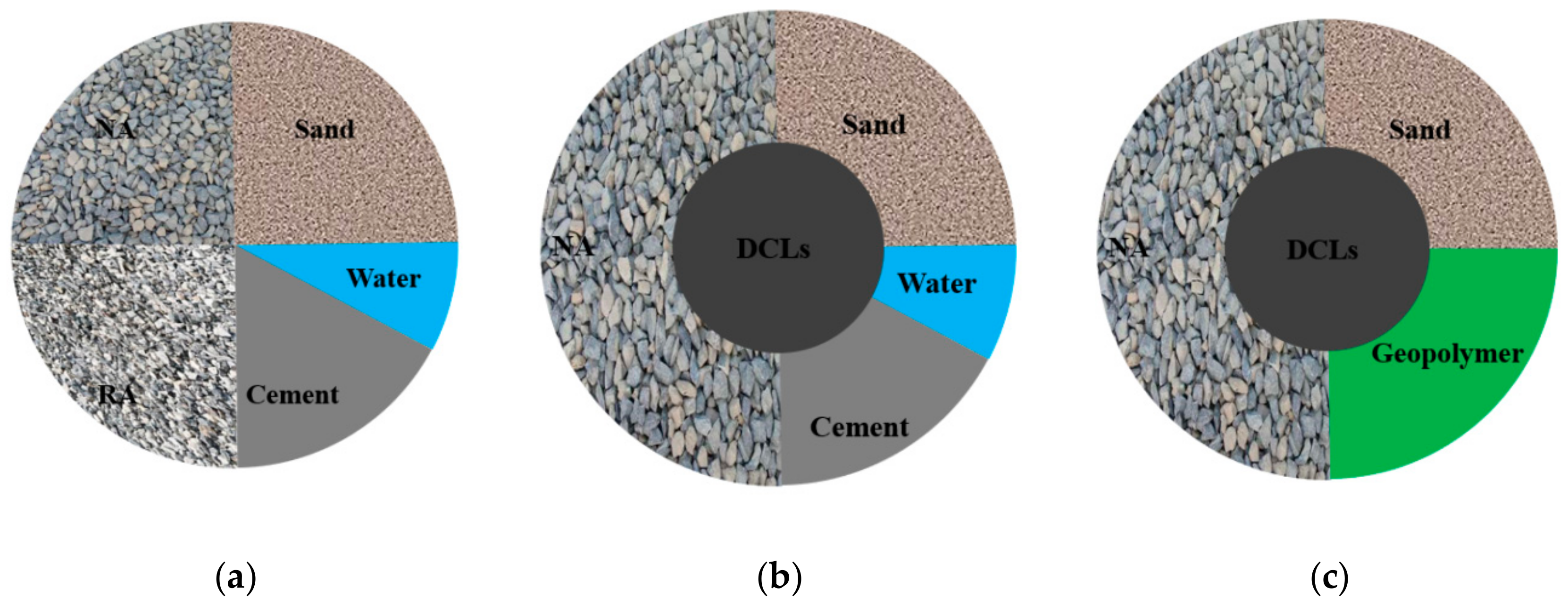
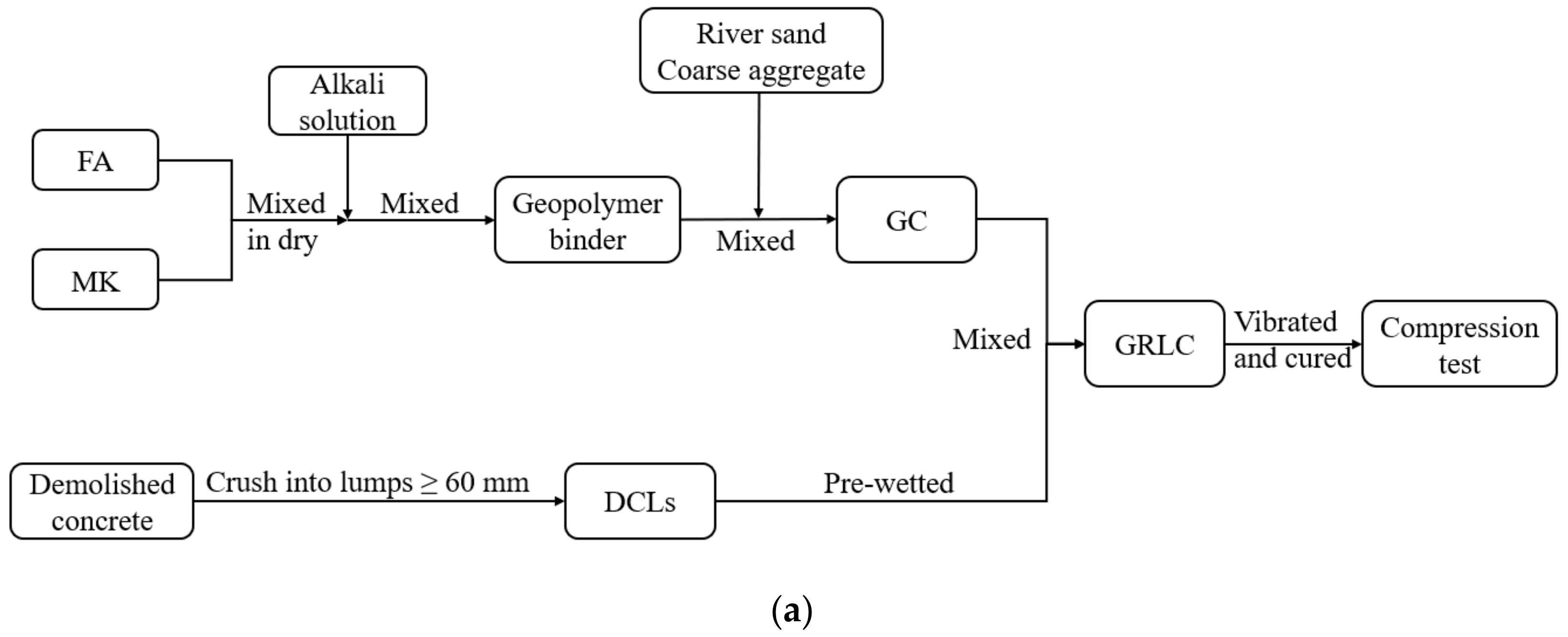

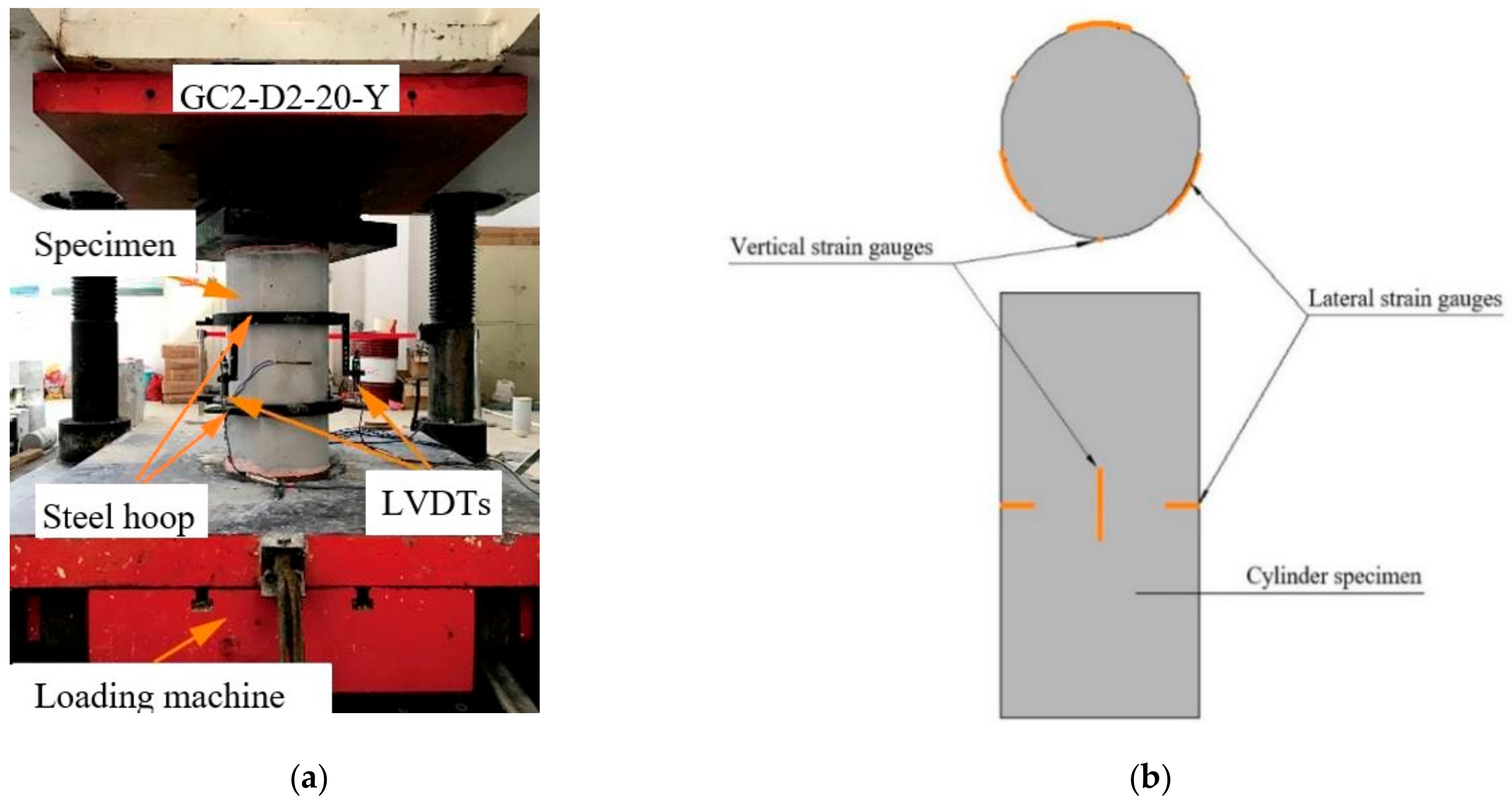
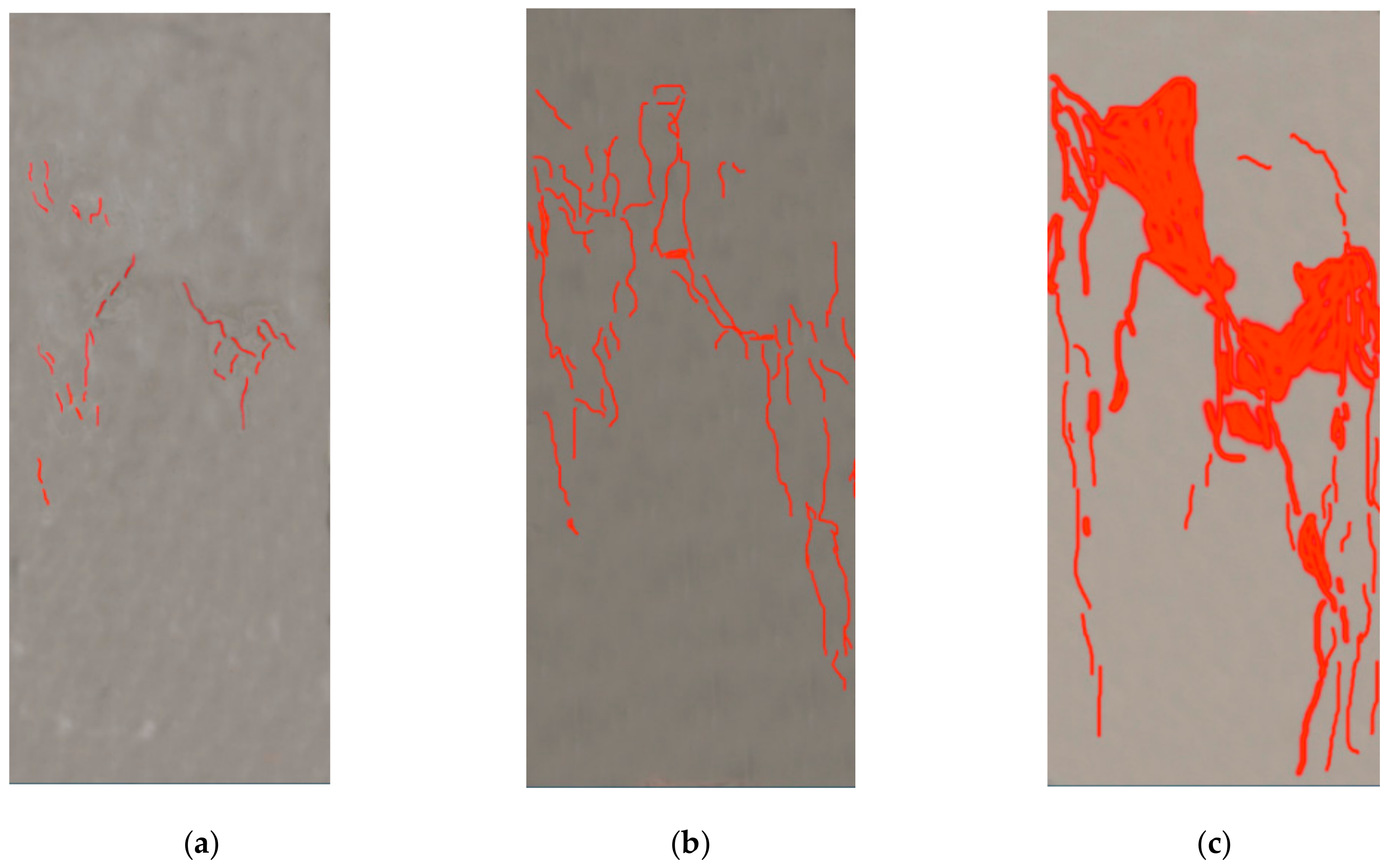



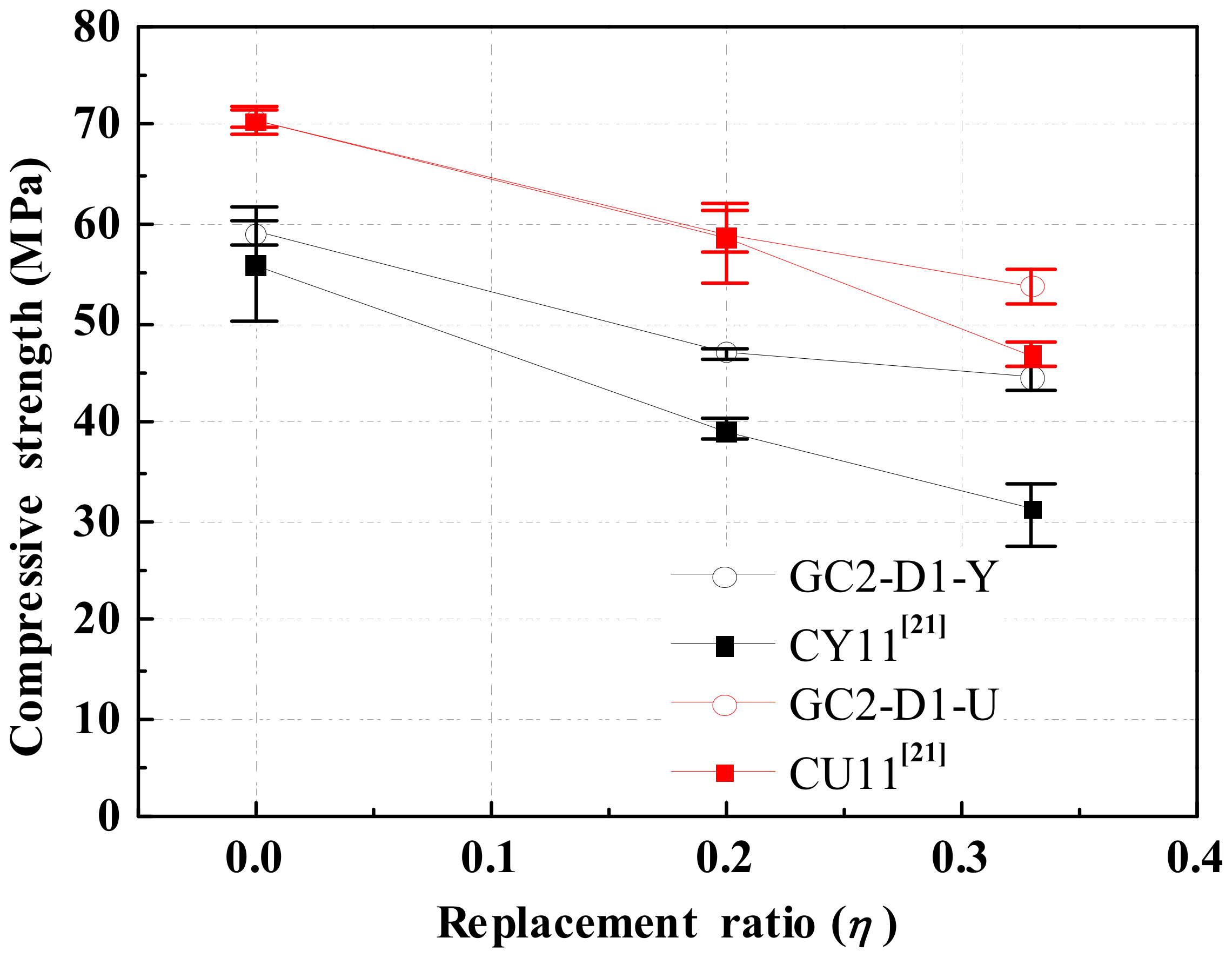
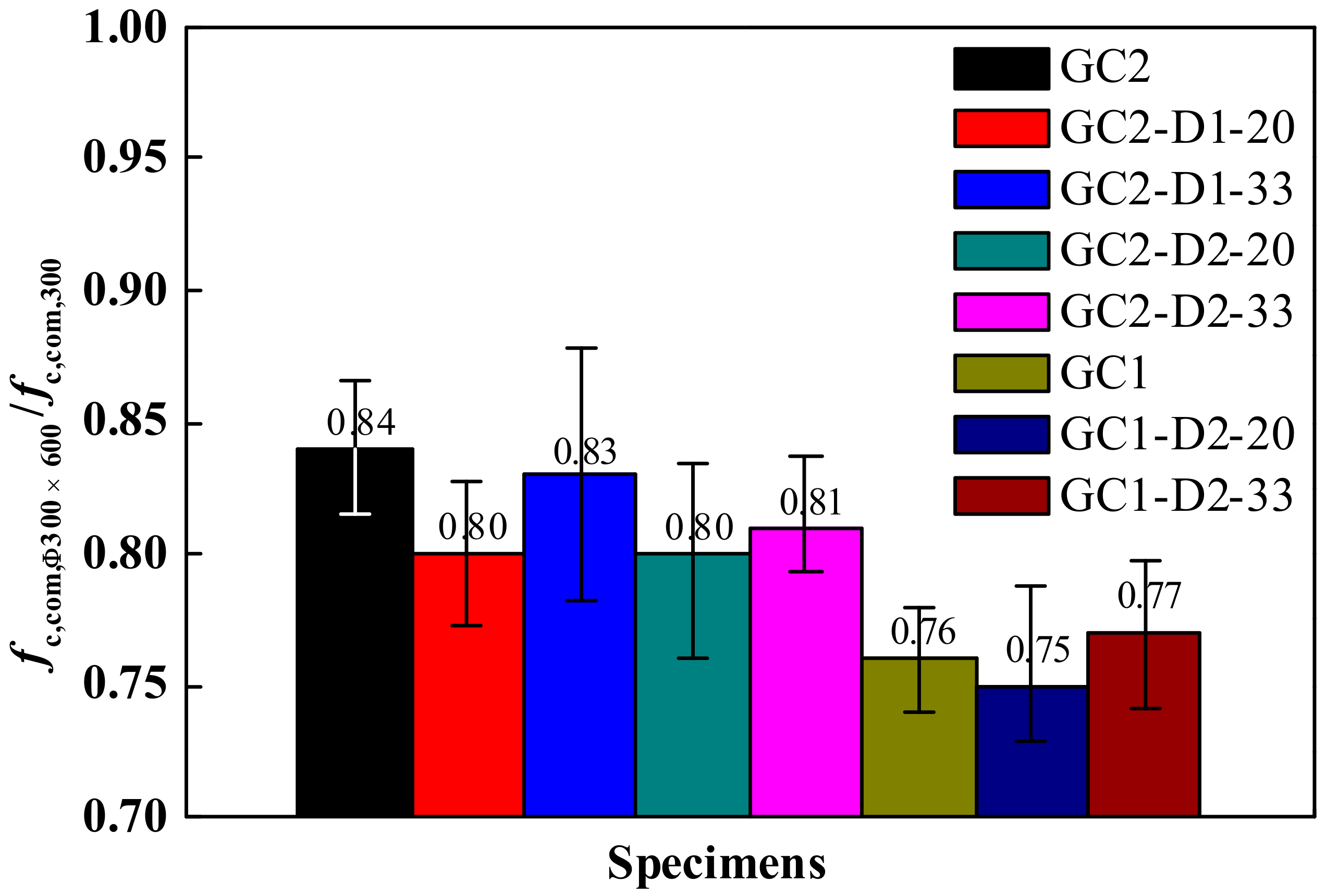
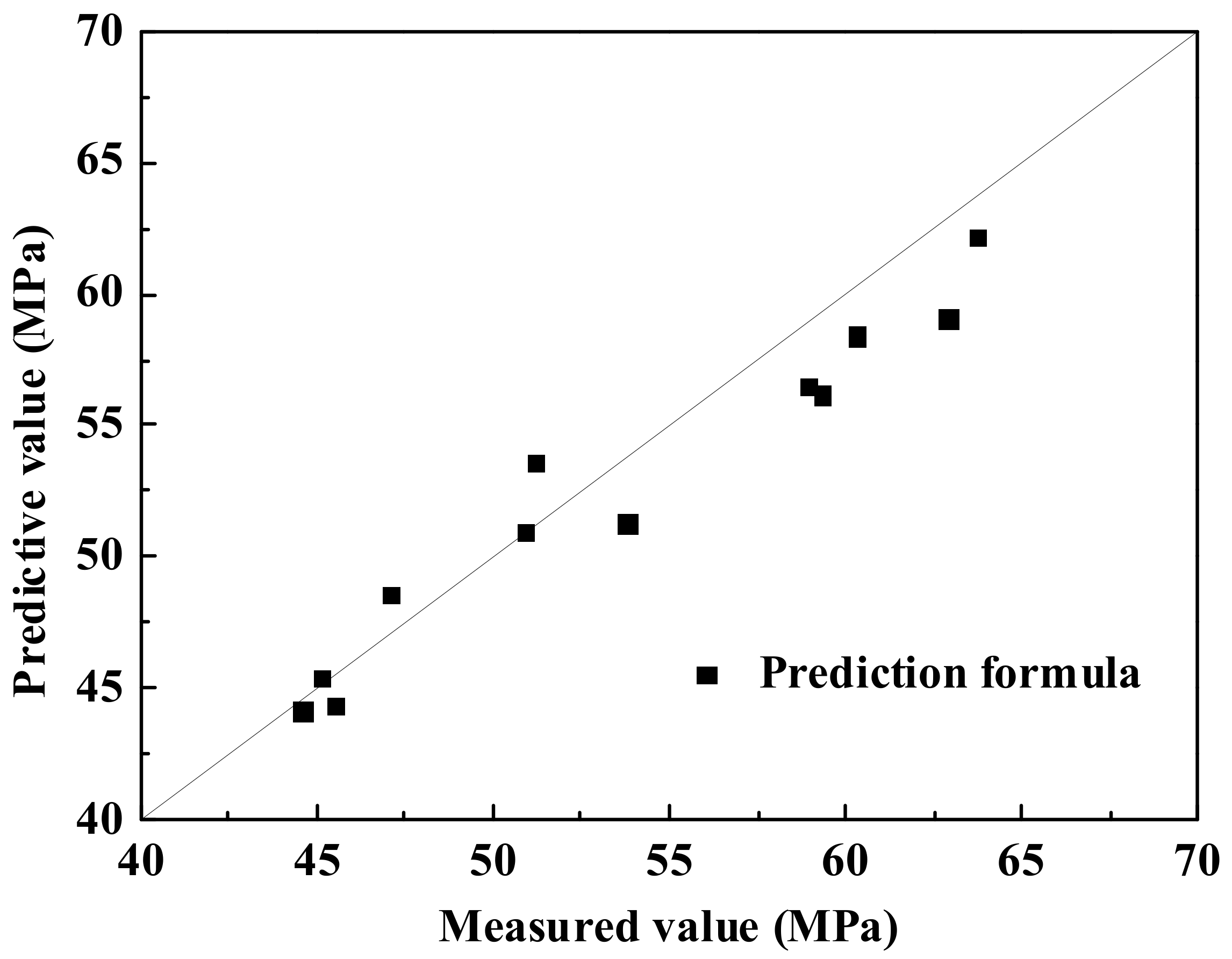
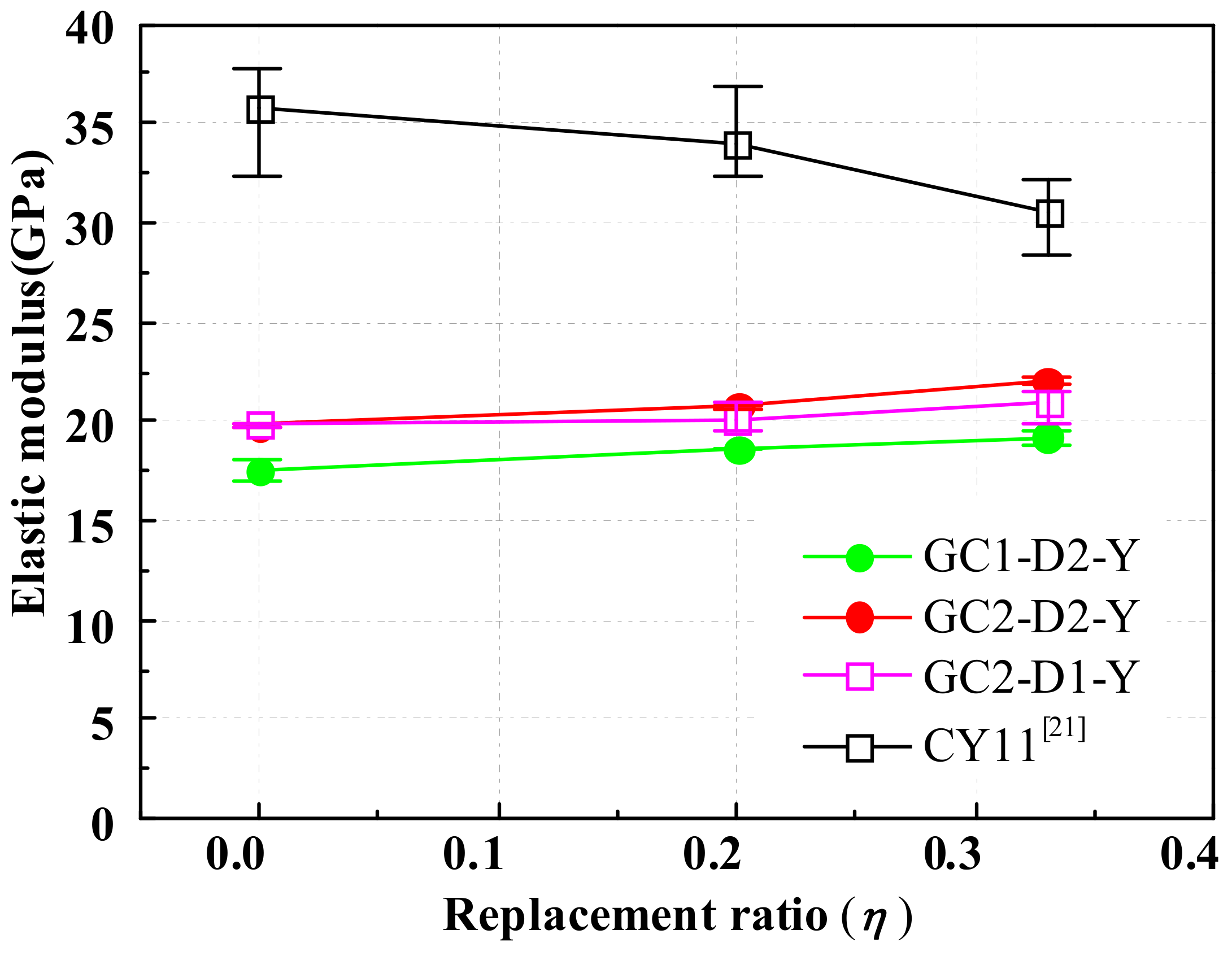
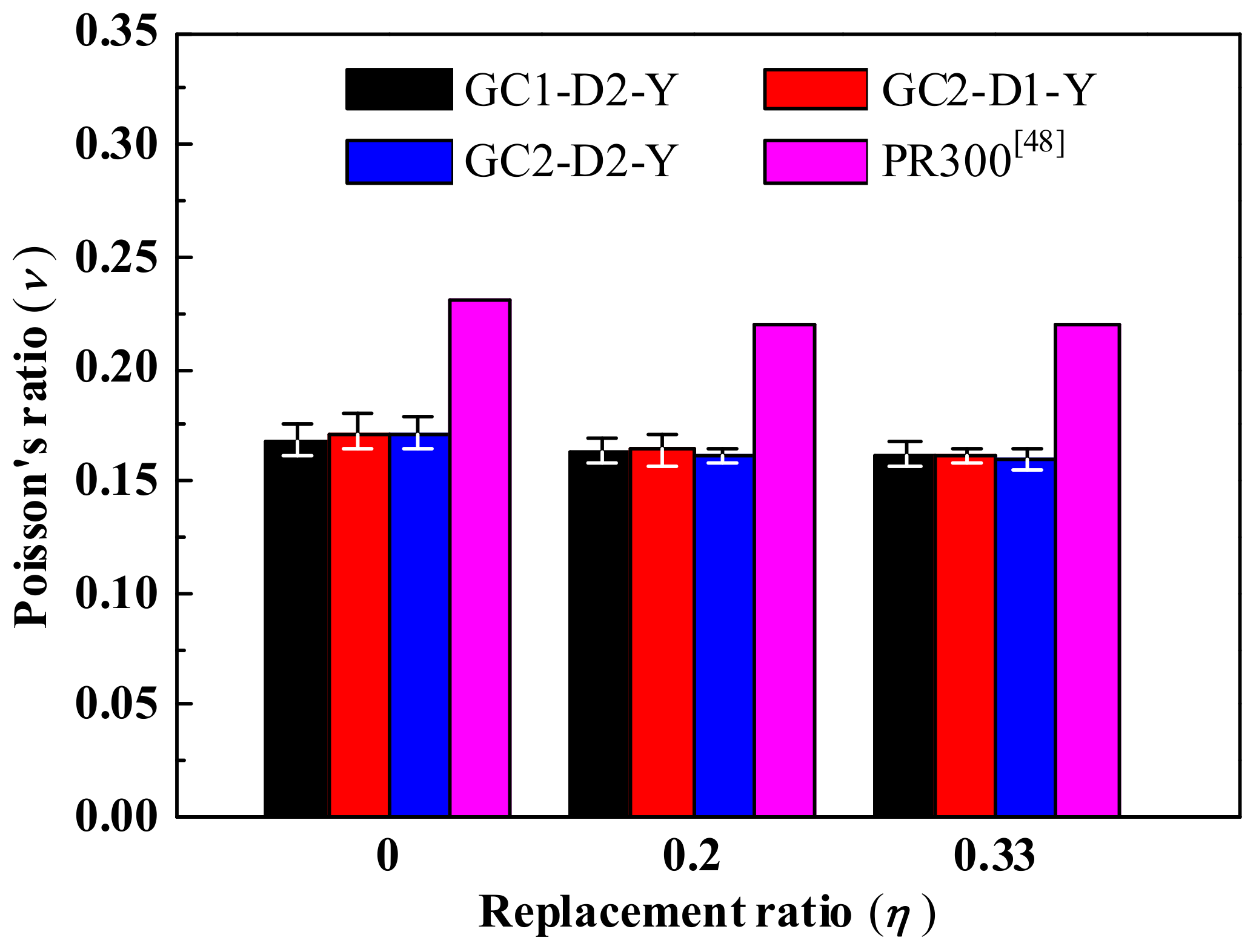
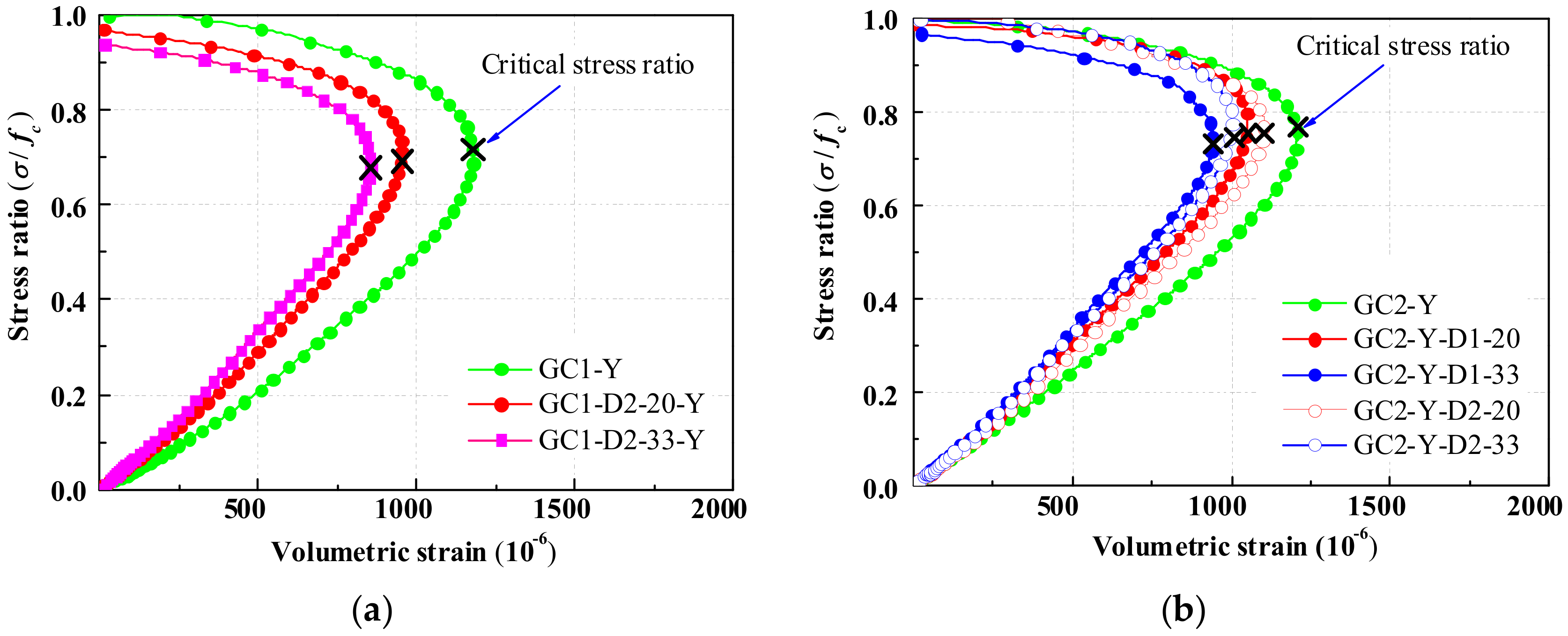
| Material | SiO2 | Al2O3 | CaO | Fe2O3 | TiO2 | SO3 | MgO | K2O | P2O5 | Others | Loss on Ignition |
|---|---|---|---|---|---|---|---|---|---|---|---|
| FA | 51.35 | 44.24 | 0.13 | 0.98 | 0.90 | 0.00 | 0.48 | 0.08 | 0.45 | 0.17 | 0.72 |
| MK | 45.3 | 41.2 | 3.77 | 3.18 | 1.62 | 0.75 | 0.44 | 0.38 | 0.36 | 0.33 | 2.40 |
| Type of Fresh Concrete | Water (kg/m3) | Cement kg/m3 | Sand (kg/m3) | Coarse Aggregate (kg/m3) | Superplasticizer (kg/m3) | Cubic Compressive Strength (MPa) |
|---|---|---|---|---|---|---|
| OPC | 175 | 547 | 611 | 1242 | 5.47 | 82.5 |
| Type of Fresh Concrete | Water (kg/m3) | MK (kg/m3) | FA (kg/m3) | Sand (kg/m3) | Coarse Aggregate (kg/m3) | KOH (kg/m3) | Potassium Silicate (kg/m3) | Cubic Compressive Strength (MPa) | Cylindrical Compressive Strength (MPa) |
|---|---|---|---|---|---|---|---|---|---|
| GC1 | 70 | 177 | 177 | 529 | 1236 | 68 | 244 | 64.8 | 47.7 |
| GC2 | 63 | 186 | 186 | 535 | 1249 | 61 | 219 | 74.0 | 59.2 |
| Group | Type of Fresh Concrete | Type of Demolished Concrete | η (%) | Specimen Shape | fcu,new,150 (MPa) | fcu,old,150 (MPa) | fc, com,300 (MPa) | |
|---|---|---|---|---|---|---|---|---|
| Measured | Calculated | |||||||
| GC1-U | GC1 | -- | -- | Cube | 64.8 | -- | 61.8 | -- |
| GC2-U | GC2 | -- | -- | Cube | 74.0 | -- | 70.6 | -- |
| OPC-U | OPC | -- | -- | Cube | 82.5 | -- | 74.4 | -- |
| GC1-D2-20-U | GC1 | D2 | 20 | Cube | 64.8 | 51.6 | 60.3 | 58.4 |
| GC1-D2-33-U | GC1 | D2 | 33 | Cube | 64.8 | 51.6 | 59.3 | 56.2 |
| GC2-D1-20-U | GC2 | D1 | 20 | Cube | 74.0 | 35.7 | 58.9 | 56.5 |
| GC2-D1-33-U | GC2 | D1 | 33 | Cube | 74.0 | 35.7 | 53.8 | 51.3 |
| GC2-D2-20-U | GC2 | D2 | 20 | Cube | 74.0 | 51.6 | 63.7 | 62.2 |
| GC2-D2-33-U | GC2 | D2 | 33 | Cube | 74.0 | 51.6 | 62.9 | 59.1 |
| OPC-D2-20-U | OPC | D2 | 20 | Cube | 82.5 | 51.6 | 63.0 | -- |
| OPC-D2-33-U | OPC | D2 | 33 | Cube | 82.5 | 51.6 | 61.4 | -- |
| GC1-Y | GC1 | -- | -- | Cylinder | 64.8 | -- | 47.7 | -- |
| GC2-Y | GC2 | -- | -- | Cylinder | 74.0 | -- | 59.2 | -- |
| GC1-D2-20-Y | GC1 | D2 | 20 | Cylinder | 64.8 | 51.6 | 45.1 | 45.4 |
| GC1-D2-33-Y | GC1 | D2 | 33 | Cylinder | 64.8 | 51.6 | 45.5 | 44.4 |
| GC2-D1-20-Y | GC2 | D1 | 20 | Cylinder | 74.0 | 35.7 | 47.1 | 48.6 |
| GC2-D1-33-Y | GC2 | D1 | 33 | Cylinder | 74.0 | 35.7 | 44.6 | 44.2 |
| GC2-D2-20-Y | GC2 | D2 | 20 | Cylinder | 74.0 | 51.6 | 51.2 | 53.6 |
| GC2-D2-33-Y | GC2 | D2 | 33 | Cylinder | 74.0 | 51.6 | 50.9 | 51.0 |
© 2020 by the authors. Licensee MDPI, Basel, Switzerland. This article is an open access article distributed under the terms and conditions of the Creative Commons Attribution (CC BY) license (http://creativecommons.org/licenses/by/4.0/).
Share and Cite
Zhang, H.; Liu, J.; Wu, B.; Zhang, Z. Axial Compressive Behavior of Geopolymer Recycled Lump Concrete. Materials 2020, 13, 533. https://doi.org/10.3390/ma13030533
Zhang H, Liu J, Wu B, Zhang Z. Axial Compressive Behavior of Geopolymer Recycled Lump Concrete. Materials. 2020; 13(3):533. https://doi.org/10.3390/ma13030533
Chicago/Turabian StyleZhang, Haiyan, Jiancheng Liu, Bo Wu, and Zhijian Zhang. 2020. "Axial Compressive Behavior of Geopolymer Recycled Lump Concrete" Materials 13, no. 3: 533. https://doi.org/10.3390/ma13030533
APA StyleZhang, H., Liu, J., Wu, B., & Zhang, Z. (2020). Axial Compressive Behavior of Geopolymer Recycled Lump Concrete. Materials, 13(3), 533. https://doi.org/10.3390/ma13030533




